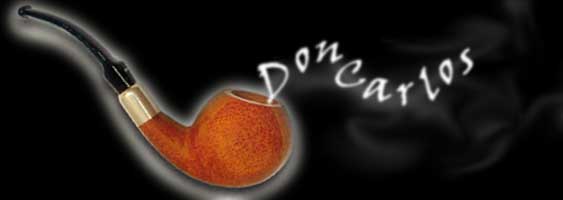 |
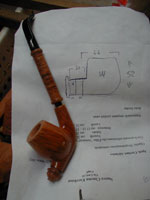 |
 A
twisting gravel road leads up to a Lego block-shaped building made of stucco.
Floor to ceiling sliding glass doors in front, lined with verticals and
potted trees, create a cool respite from the afternoon sun. The concrete
floor of the work area is a maze of stacked crates, large burlap sacks,
and various machines. A breeze whirls through the garage style room causing
tacked up papers and wood shavings to flutter about. The aromas of lacquer
and tree bark mix together and surround Bruto Sardini, a master pipe craftsman,
as he fires one of his creations over an oil burning flame. A
twisting gravel road leads up to a Lego block-shaped building made of stucco.
Floor to ceiling sliding glass doors in front, lined with verticals and
potted trees, create a cool respite from the afternoon sun. The concrete
floor of the work area is a maze of stacked crates, large burlap sacks,
and various machines. A breeze whirls through the garage style room causing
tacked up papers and wood shavings to flutter about. The aromas of lacquer
and tree bark mix together and surround Bruto Sardini, a master pipe craftsman,
as he fires one of his creations over an oil burning flame.
 Bruto discovered
his natural talent for pipe making some 25 years ago. Dissatisfied with
the different styles of pipes he had tried, he decided to make his own.
Having a limited knowledge of necessary techniques, Bruto searched for someone
willing to teach him and eventually discovered the now late Primo Soriani,
who had created pipes using techniques that were adapted Bruto discovered
his natural talent for pipe making some 25 years ago. Dissatisfied with
the different styles of pipes he had tried, he decided to make his own.
Having a limited knowledge of necessary techniques, Bruto searched for someone
willing to teach him and eventually discovered the now late Primo Soriani,
who had created pipes using techniques that were adapted |
| |
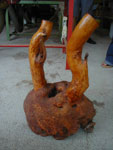 |
from
the early 1900s. With Primo’s guidance, Bruto began his apprenticeship and
truly enjoyed exercising his personal creativity.
 While studying law
at the University of Urbino, Bruto continued to pursue his fascination with
pipe making. He crafted pipes, sold them on campus, and supported his studies
with the revenue. Eventually, a fellow pipe craftsman and friend suggested
they create a small business together. Bruto accepted and assumed the venture
would last about two years. Bruto was While studying law
at the University of Urbino, Bruto continued to pursue his fascination with
pipe making. He crafted pipes, sold them on campus, and supported his studies
with the revenue. Eventually, a fellow pipe craftsman and friend suggested
they create a small business together. Bruto accepted and assumed the venture
would last about two years. Bruto was |
| |
|
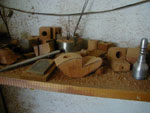 |
mistaken. Five years later, Bruto was still making pipes. He chose not to return to school and instead decided to move to the mountains of Cagli where he finds “great inspiration” in nature. |
 Bruto
extinguishes the flame and looks up through his glasses. His workbench is
decorated with several different styles of pipes, bottles of lacquer, sheets
of sandpaper and tufts of cotton. Soon, he retreats into a backroom and
emerges with a mass of wood, placing it on the floor. The structure is an
uprooted tree, sans roots, branches and leaves. The plant, Italian briar
(Ericabotanica), is indigenous to the Mediterranean Basin. The large burl
connecting the roots and the trunk is the material that Bruto uses to make
his pipes. After being unearthed and before being delivered to Bruto, the
bulb is sent to a woodcarver. There, the wood is separated into blocks,
each about the size of a brick. The wood then undergoes a boiling process
to cleanse it and preserve the moisture. Bruto then lets this wood age naturally
for two years before he begins his work. Bruto
extinguishes the flame and looks up through his glasses. His workbench is
decorated with several different styles of pipes, bottles of lacquer, sheets
of sandpaper and tufts of cotton. Soon, he retreats into a backroom and
emerges with a mass of wood, placing it on the floor. The structure is an
uprooted tree, sans roots, branches and leaves. The plant, Italian briar
(Ericabotanica), is indigenous to the Mediterranean Basin. The large burl
connecting the roots and the trunk is the material that Bruto uses to make
his pipes. After being unearthed and before being delivered to Bruto, the
bulb is sent to a woodcarver. There, the wood is separated into blocks,
each about the size of a brick. The wood then undergoes a boiling process
to cleanse it and preserve the moisture. Bruto then lets this wood age naturally
for two years before he begins his work.
 Bruto sketches the
outline of a pipe on an aged piece of wood and brings Bruto sketches the
outline of a pipe on an aged piece of wood and brings |
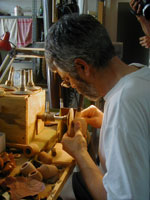 |
| it over to a saw. After the buzzing of the saw ceases and the light covering of dust is brushed away, Bruto holds up the sculpted piece of wood, now shaped into a “Bent Dublin” pipe. Bruto advances to another machine where he places the wood in a vise. He then drills the cammino or chimney (reservoir for the tobacco) and afterward drills the floccalggio or flock |
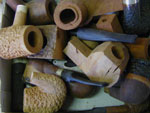 |
Click on Bruto to see him work his magic |
| (where
the bit is inserted). Bruto drills with patience and precision to ensure
that the two separate chambers will connect at precisely the right point.
Bruto uses a sander to scale the pipe down and create symmetrical sides. |
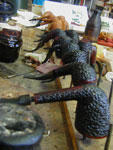 |
|
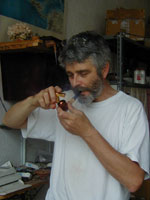 |
 Bruto and his co-workers create over 100 various shapes and grades of Don
Carlos pipes, named after Bruto’s favorite music, “Don Carlos” by Vivaldi.
The pipes are exported to Russia, Germany, Austria, and the United States.
Bruto and his co-workers create over 100 various shapes and grades of Don
Carlos pipes, named after Bruto’s favorite music, “Don Carlos” by Vivaldi.
The pipes are exported to Russia, Germany, Austria, and the United States.
 All Don Carlos pipes
are crafted with extraordinary care and precise technique. Bruto prides
himself on creating some of the finest pipes in the world, believing that
the quality of the work he creates is more important than the quantity.
Over the past ten years, just over 10,000 pipes have been produced and only
20 have been returned. All Don Carlos pipes are created with such confidence
that they come with lifetime satisfaction guarantee. If a customer is not
pleased with their pipe, Bruto responds immediately. For Bruto, creating
exquisite pipes is a labor of love. All Don Carlos pipes
are crafted with extraordinary care and precise technique. Bruto prides
himself on creating some of the finest pipes in the world, believing that
the quality of the work he creates is more important than the quantity.
Over the past ten years, just over 10,000 pipes have been produced and only
20 have been returned. All Don Carlos pipes are created with such confidence
that they come with lifetime satisfaction guarantee. If a customer is not
pleased with their pipe, Bruto responds immediately. For Bruto, creating
exquisite pipes is a labor of love. |
Graphic Design: Danielle Dinardo & Lindsay Mead
Design Production: Danielle Dinardo & Lindsay Mead
Writing: Raina G. Patrocinio
Photography: Danielle Dinardo
Videography: Bob Buhowski
|







